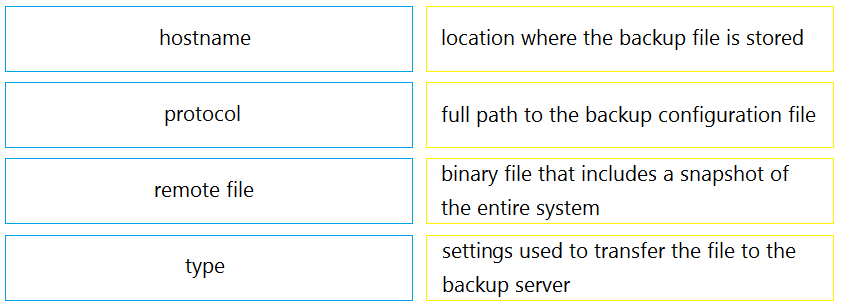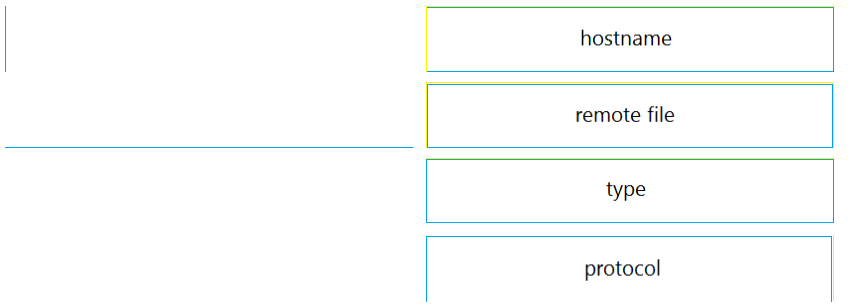A network engineer is deploying a Cisco All-Flash HyperFlex solution. Which local storage configuration is required for the operating system and persistent logging?
A
Reference:
https://www.cisco.com/c/en/us/support/docs/voice/telephony-signaling/212102-Configure-Persistent-Logging-on-Cisco-IO.html
DRAG DROP -
Drag and drop the fields for configuring a full state backup file of the Cisco UCS Manager from the left onto the descriptions on the right.
Select and Place:

An engineer configures an Intersight Virtual Appliance and must claim over 200 targets. The engineer starts the Claim New Target Procedure. The engineer has prepared this initial comma-separated value file to provision the targets:
UCSFI,10.1.1.3,user-1,pwd5516b917
IMC,10.1.1.5/26,user-2,pwdc65b1c43f
HX,10.1.2.1/30,user-3,pwd39913690
UCSD,1.1.1.1.user-4,pwd5003e9d5 -
Which information must be included in the comma-separated value file to provision the targets?
A
For each target, add a line containing Target Type, Hostname or IP Address, User Name, and Password. Use the CIDR notation to specify the IP Range. You can add as many lines with these details in the .csv file.
Reference:
https://intersight.com/help/appliance/getting_started/claim_targets
Which component is disrupted when the Cisco Integrated Management Controller is upgraded on a Cisco UCS Series Server?
B
The CIMC Firmware Update Utility is used to update the firmware versions for host(x86)-based systems for standalone servers. To update the firmware, you must restart the host system to either the Linux operating system or to the EFI prompt. You can use the procedures to update the firmware version using KVM as well.
Although the procedure to update the firmware version using Linux, EFI, or KVM is the same, be aware that when you activate the new firmware version, the connection to the CIMC is reset, and the KVM window will close.
Reference:
https://www.cisco.com/c/en/us/td/docs/unified_computing/ucs/c/sw/fwp/user/guide/Firmware_Upgrade_Utility/Using.pdf
Which two configuration settings are available in the Cisco UCS Firmware Auto Sync Server policy? (Choose two.)
CE
You can use the Firmware Auto Sync Server policy in Cisco UCS Manager to determine wheth-er firmware versions on recently discovered servers must be upgraded or not. With this policy, you can upgrade the firmware versions of recently discovered unassociated servers to match the firmware version defined in the default host firmware pack. In addition, you can determine if the firmware upgrade process should run immediately after the server is discovered, or run at a later time.
Following are the values for the Firmware Auto Sync Server policy:
ג€¢ No Action ג€" No firmware upgrade is initiated on the server.
This value is selected by default.
ג€¢ User Acknowledge ג€" Firmware on the server is not synchronized until the administrator acknowledges the upgrade in the Pending Activities dialog box.
Reference:
https://www.cisco.com/c/en/us/td/docs/unified_computing/ucs/ucs-manager/CLI-User-Guides/Firmware-Mgmt/3-1/ b_UCSM_CLI_Firmware_Management_Guide_3_1/b_UCSM_GUI_Firmware_Management_Guide_3_1_chapter_011.html
A Cisco Nexus 9000 Series Switch experiences a startup configuration corruption. The engineer must implement a procedure to recover the backup configuration file from the switch. Which command set must be used?
A
Rolling Back to a Previous Configuration
To roll back your configuration to a snapshot copy of a previously saved configuration, you need to perform the following steps:
1. Clear the current running image with the write erase command.
2. Restart the device with the reload command.
3. Copy the previously saved configuration file to the running configuration with the copy configuration-file running-configuration command.
4. Copy the running configuration to the start-up configuration with the copy running-config startup-config command.
Reference:
https://www.cisco.com/c/en/us/td/docs/switches/datacenter/nexus9000/sw/7-x/fundamentals/configuration/guide/b_Cisco_Nexus_9000_Series_NX-
OS_Fundamentals_Configuration_Guide_7x/b_Cisco_Nexus_9000_Series_NX-OS_Fundamentals_Configuration_Guide_7x_chapter_01001.html
An engineer configures the properties of a Cisco UCS Cisco Integrated Management Controller network adapter for a standalone Cisco C-Series Server. The
Failback Timeout in the vNIC was set to 600. When the failure occurs, the secondary interfaces must be used and then failback when the primary interface becomes available again. Which action must be taken to meet these requirements?
C

Reference:
https://www.cisco.com/c/en/us/td/docs/unified_computing/ucs/c/sw/gui/config/guide/4_2/b_cisco_ucs_c-series_gui_configuration_guide_42/ b_Cisco_UCS_C-series_GUI_Configuration_Guide_41_chapter_01011.html#task_1696A32C1FD640688DE706384B9A1E76
An engineer must perform a backup operation of the Cisco UCS system. The backup must be transferred to a secure location using UDP and must contain information about VLANs, VSANs, and other policies. Also, the operations team requires the backup file to be in a human-readable format. Which configuration set meets these requirements?
C
TFTP is the only protocol that uses UDP port 69. Logical State backup includes all logical configuration contains settings such as service profiles, VLANs, VSANs, pools, and policies.
Reference:
https://www.cisco.com/c/en/us/td/docs/unified_computing/ucs/sw/cli/config/guide/1-0-2/b_CLI_Config_Guide_1-0-2/CLI_Config_Guide_1-0-2_chapter29.pdf
When deploying a Cisco HyperFlex edge with a pair of switches, what is the minimum number of interfaces in trunk mode required on each HX node?
B
Dual switch configuration provides a slightly more complex topology with full redundancy that protects against: switch failure, link failure, and port failure. It requires two switches that may be standalone or stacked, and two 10/25GE ports, one 1GE port for CIMC management, and one Cisco VIC 1457 per server.
Trunk ports are the only supported network port configuration.
Reference:
https://www.cisco.com/c/en/us/td/docs/hyperconverged_systems/HyperFlex_HX_DataPlatformSoftware/Edge_Deployment_Guide/b-hx-edge- preinstall-checklist/m-3-and-4-node-preinstall-chklist.html
What is a benefit of independent resource scaling in Cisco HyperFlex hybrid architecture?
B
Reference:
https://www.cisco.com/c/en/us/products/collateral/hyperconverged-infrastructure/hyperflex-hx-series/solution-overview-c22-744674.html